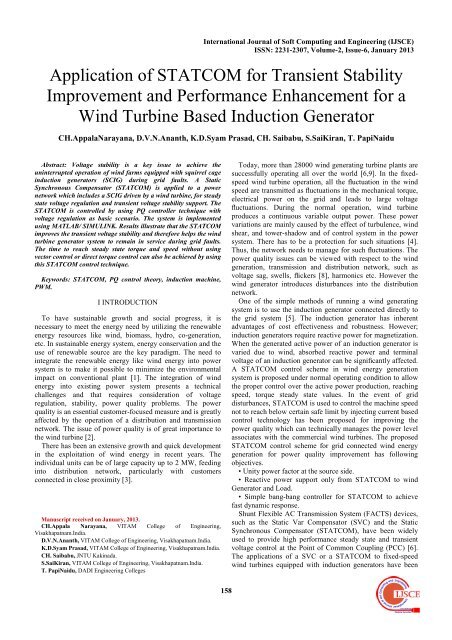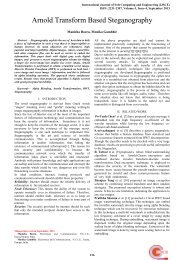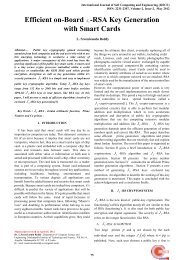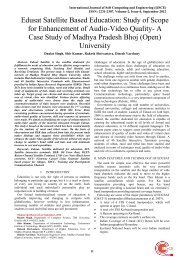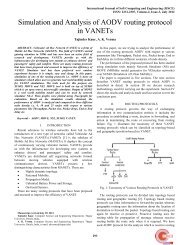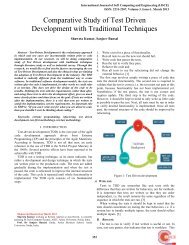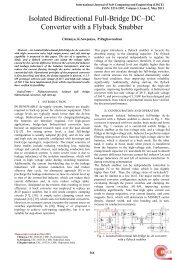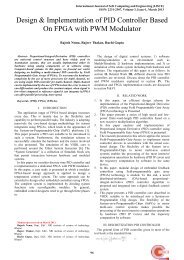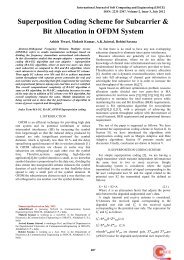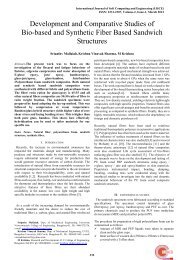Application of STATCOM for Transient Stability Improvement and ...
Application of STATCOM for Transient Stability Improvement and ...
Application of STATCOM for Transient Stability Improvement and ...
Create successful ePaper yourself
Turn your PDF publications into a flip-book with our unique Google optimized e-Paper software.
International Journal <strong>of</strong> S<strong>of</strong>t Computing <strong>and</strong> Engineering (IJSCE)<br />
ISSN: 2231-2307, Volume-2, Issue-6, January 2013<br />
<strong>Application</strong> <strong>of</strong> <strong>STATCOM</strong> <strong>for</strong> <strong>Transient</strong> <strong>Stability</strong><br />
<strong>Improvement</strong> <strong>and</strong> Per<strong>for</strong>mance Enhancement <strong>for</strong> a<br />
Wind Turbine Based Induction Generator<br />
CH.AppalaNarayana, D.V.N.Ananth, K.D.Syam Prasad, CH. Saibabu, S.SaiKiran, T. PapiNaidu<br />
Abstract: Voltage stability is a key issue to achieve the<br />
uninterrupted operation <strong>of</strong> wind farms equipped with squirrel cage<br />
induction generators (SCIG) during grid faults. A Static<br />
Synchronous Compensator (<strong>STATCOM</strong>) is applied to a power<br />
network which includes a SCIG driven by a wind turbine, <strong>for</strong> steady<br />
state voltage regulation <strong>and</strong> transient voltage stability support. The<br />
<strong>STATCOM</strong> is controlled by using PQ controller technique with<br />
voltage regulation as basic scenario. The system is implemented<br />
using MATLAB/ SIMULINK. Results illustrate that the <strong>STATCOM</strong><br />
improves the transient voltage stability <strong>and</strong> there<strong>for</strong>e helps the wind<br />
turbine generator system to remain in service during grid faults.<br />
The time to reach steady state torque <strong>and</strong> speed without using<br />
vector control or direct torque control can also be achieved by using<br />
this <strong>STATCOM</strong> control technique.<br />
Keywords: <strong>STATCOM</strong>, PQ control theory, induction machine,<br />
PWM.<br />
I INTRODUCTION<br />
To have sustainable growth <strong>and</strong> social progress, it is<br />
necessary to meet the energy need by utilizing the renewable<br />
energy resources like wind, biomass, hydro, co-generation,<br />
etc. In sustainable energy system, energy conservation <strong>and</strong> the<br />
use <strong>of</strong> renewable source are the key paradigm. The need to<br />
integrate the renewable energy like wind energy into power<br />
system is to make it possible to minimize the environmental<br />
impact on conventional plant [1]. The integration <strong>of</strong> wind<br />
energy into existing power system presents a technical<br />
challenges <strong>and</strong> that requires consideration <strong>of</strong> voltage<br />
regulation, stability, power quality problems. The power<br />
quality is an essential customer-focused measure <strong>and</strong> is greatly<br />
affected by the operation <strong>of</strong> a distribution <strong>and</strong> transmission<br />
network. The issue <strong>of</strong> power quality is <strong>of</strong> great importance to<br />
the wind turbine [2].<br />
There has been an extensive growth <strong>and</strong> quick development<br />
in the exploitation <strong>of</strong> wind energy in recent years. The<br />
individual units can be <strong>of</strong> large capacity up to 2 MW, feeding<br />
into distribution network, particularly with customers<br />
connected in close proximity [3].<br />
Manuscript received on January, 2013.<br />
CH.Appala Narayana, VITAM College <strong>of</strong> Engineering,<br />
Visakhapatnam.India.<br />
D.V.N.Ananth, VITAM College <strong>of</strong> Engineering, Visakhapatnam.India.<br />
K.D.Syam Prasad, VITAM College <strong>of</strong> Engineering, Visakhapatnam.India.<br />
CH. Saibabu, JNTU Kakinada.<br />
S.SaiKiran, VITAM College <strong>of</strong> Engineering, Visakhapatnam.India.<br />
T. PapiNaidu, DADI Engineering Colleges<br />
Today, more than 28000 wind generating turbine plants are<br />
successfully operating all over the world [6,9]. In the fixedspeed<br />
wind turbine operation, all the fluctuation in the wind<br />
speed are transmitted as fluctuations in the mechanical torque,<br />
electrical power on the grid <strong>and</strong> leads to large voltage<br />
fluctuations. During the normal operation, wind turbine<br />
produces a continuous variable output power. These power<br />
variations are mainly caused by the effect <strong>of</strong> turbulence, wind<br />
shear, <strong>and</strong> tower-shadow <strong>and</strong> <strong>of</strong> control system in the power<br />
system. There has to be a protection <strong>for</strong> such situations [4].<br />
Thus, the network needs to manage <strong>for</strong> such fluctuations. The<br />
power quality issues can be viewed with respect to the wind<br />
generation, transmission <strong>and</strong> distribution network, such as<br />
voltage sag, swells, flickers [8], harmonics etc. However the<br />
wind generator introduces disturbances into the distribution<br />
network.<br />
One <strong>of</strong> the simple methods <strong>of</strong> running a wind generating<br />
system is to use the induction generator connected directly to<br />
the grid system [5]. The induction generator has inherent<br />
advantages <strong>of</strong> cost effectiveness <strong>and</strong> robustness. However;<br />
induction generators require reactive power <strong>for</strong> magnetization.<br />
When the generated active power <strong>of</strong> an induction generator is<br />
varied due to wind, absorbed reactive power <strong>and</strong> terminal<br />
voltage <strong>of</strong> an induction generator can be significantly affected.<br />
A <strong>STATCOM</strong> control scheme in wind energy generation<br />
system is proposed under normal operating condition to allow<br />
the proper control over the active power production, reaching<br />
speed, torque steady state values. In the event <strong>of</strong> grid<br />
disturbances, <strong>STATCOM</strong> is used to control the machine speed<br />
not to reach below certain safe limit by injecting current based<br />
control technology has been proposed <strong>for</strong> improving the<br />
power quality which can technically manages the power level<br />
associates with the commercial wind turbines. The proposed<br />
<strong>STATCOM</strong> control scheme <strong>for</strong> grid connected wind energy<br />
generation <strong>for</strong> power quality improvement has following<br />
objectives.<br />
• Unity power factor at the source side.<br />
• Reactive power support only from <strong>STATCOM</strong> to wind<br />
Generator <strong>and</strong> Load.<br />
• Simple bang-bang controller <strong>for</strong> <strong>STATCOM</strong> to achieve<br />
fast dynamic response.<br />
Shunt Flexible AC Transmission System (FACTS) devices,<br />
such as the Static Var Compensator (SVC) <strong>and</strong> the Static<br />
Synchronous Compensator (<strong>STATCOM</strong>), have been widely<br />
used to provide high per<strong>for</strong>mance steady state <strong>and</strong> transient<br />
voltage control at the Point <strong>of</strong> Common Coupling (PCC) [6].<br />
The applications <strong>of</strong> a SVC or a <strong>STATCOM</strong> to fixed-speed<br />
wind turbines equipped with induction generators have been<br />
158
<strong>Application</strong> <strong>of</strong> <strong>STATCOM</strong> <strong>for</strong> <strong>Transient</strong> <strong>Stability</strong> <strong>Improvement</strong> <strong>and</strong> Per<strong>for</strong>mance Enhancement <strong>for</strong> a Wind<br />
Turbine Based Induction Generator<br />
reported in [7] <strong>for</strong> steady state voltage regulation, <strong>and</strong> in [1]<br />
<strong>for</strong> short-term transient voltage stability.<br />
The paper is organized as fallows. The Section II introduces<br />
the wind turbine model. The Section III introduces<br />
<strong>STATCOM</strong> controller <strong>and</strong> overall system design in<br />
MATLAB. The Section IV describes the topology <strong>for</strong> power<br />
quality improvement. The Sections V, VI, VII describes the<br />
result analysis, conclusions <strong>and</strong> references respectively.<br />
II. WIND TURBINE MODEL<br />
The aerodynamic model <strong>of</strong> a wind turbine can be<br />
characterized by the well-known CP-λ-β curves. CP is called<br />
power coefficient, which is a function <strong>of</strong> both tip-speed-ratio λ<br />
<strong>and</strong> the blade pitch angle β. The tip-speed-ratio λ is defined by<br />
III. <strong>STATCOM</strong> MODEL<br />
A <strong>STATCOM</strong> [6], [12], also known as an advanced static<br />
VAR compensator, is a shunt connected FACTS device. It<br />
generates a set <strong>of</strong> balanced three-phase sinusoidal voltages at<br />
the fundamental frequency, with rapidly controllable<br />
amplitude <strong>and</strong> phase angle. A typical application <strong>of</strong> a<br />
<strong>STATCOM</strong> is <strong>for</strong> voltage support. In this paper, the<br />
<strong>STATCOM</strong> is modeled as a IGBT PWM converter with a dclink<br />
capacitor. The objective <strong>of</strong> the <strong>STATCOM</strong> is to regulate<br />
the voltage at the PCC rapidly in the desired range <strong>and</strong> keep<br />
its dc-link voltage constant. It can enhance the capability <strong>of</strong><br />
the wind turbine to ride through transient disturbances in the<br />
grid. The overall control scheme <strong>of</strong> the <strong>STATCOM</strong> is shown<br />
in Fig. 2.<br />
Λ= ω t R/v w (1)<br />
where R is the blade length in m, ωt is the wind turbine rotor<br />
speed in rad/s, <strong>and</strong> vw is the wind speed in m/s. The CP-λ-β<br />
curves depend on the blade design <strong>and</strong> are given by the wind<br />
turbine manufacturer. Given the power coefficient CP, the<br />
mechanical power extracted by the turbine from the wind, is<br />
calculated by [1], [8]<br />
(2)<br />
where ρ is the air density in kg/m 3 ; Ar = πR2 is the area in m2<br />
swept by the rotor blades. At a specific wind speed, there is a<br />
unique value <strong>of</strong> ωt to achieve the maximum power coefficient<br />
CP <strong>and</strong> thereby extract the maximum mechanical (wind)<br />
power. If the wind speed is below the rated (maximum) value,<br />
the wind turbine operates in the variable speed mode, <strong>and</strong> the<br />
rotational speed is adjusted (by means <strong>of</strong> active power control<br />
in the DFIG) such that the maximum value <strong>of</strong> CP is achieved.<br />
In this operating mode, the wind turbine pitch control is<br />
deactivated <strong>and</strong> the pitch angle β is fixed at 0○. If the wind<br />
speed is above the rated value, the rotor speed can no longer<br />
be controlled within the limits by increasing the generated<br />
power, as this would lead to overloading <strong>of</strong> the generator<br />
<strong>and</strong>/or the converter. In this situation, the pitch control is<br />
activated to increase the wind turbine pitch angle to reduce the<br />
mechanical power extracted from wind. Figure 5 shows the<br />
structure <strong>of</strong> the pitch angle controller [1], [8]. Pt (= Ps + Pr) is<br />
the total output active power from the induction generator.<br />
Fig. 1. Wind turbine pitch angle controller<br />
Fig. 2. Control scheme <strong>of</strong> the <strong>STATCOM</strong>.<br />
In its most basic <strong>for</strong>m, the <strong>STATCOM</strong> configuration<br />
consists <strong>of</strong> a VSC, a dc energy storage device; a coupling<br />
trans<strong>for</strong>mer connected in shunt with the ac system, <strong>and</strong><br />
associated control circuits. Fig.3, shows the basic<br />
configuration <strong>of</strong> <strong>STATCOM</strong> with wind turbine driven SCIG<br />
connected directly to the grid. The VSC converts the dc<br />
voltage across the storage device into a set <strong>of</strong> three-phase ac<br />
output voltages. These voltages are in phase <strong>and</strong> coupled with<br />
the ac system through the reactance <strong>of</strong> the coupling<br />
trans<strong>for</strong>mer. Suitable adjustment <strong>of</strong> the phase <strong>and</strong> magnitude<br />
<strong>of</strong> the <strong>STATCOM</strong> output voltages allows effective control <strong>of</strong><br />
active <strong>and</strong> reactive power exchanges between the <strong>STATCOM</strong><br />
<strong>and</strong> the ac system.<br />
The VSC connected in shunt with the ac system provides a<br />
multifunctional topology which can be used <strong>for</strong> up to three<br />
quite distinct purposes:<br />
1) Voltage regulation <strong>and</strong> compensation <strong>of</strong> reactive power<br />
2) Correction <strong>of</strong> power factor<br />
3) Elimination <strong>of</strong> current harmonics.<br />
The design approach <strong>of</strong> the control system determines the<br />
priorities <strong>and</strong> functions developed in this analysis. In this<br />
paper, the <strong>STATCOM</strong> is used to regulate voltage at the point<br />
159
International Journal <strong>of</strong> S<strong>of</strong>t Computing <strong>and</strong> Engineering (IJSCE)<br />
ISSN: 2231-2307, Volume-2, Issue-6, January 2013<br />
<strong>of</strong> connection. The control is based on discrete PWM <strong>and</strong> only<br />
requires the measurement <strong>of</strong> the rms voltage at the load point,<br />
reference voltage near the grid <strong>and</strong> dc voltage near the<br />
<strong>STATCOM</strong> VSC converter.<br />
The wind energy generating system is connected with grid<br />
having the nonlinear load. The per<strong>for</strong>mance <strong>of</strong> the system is<br />
measured by switching the <strong>STATCOM</strong> at time s in the system<br />
<strong>and</strong> how the <strong>STATCOM</strong> responds to the step change<br />
comm<strong>and</strong> <strong>for</strong> increase in additional load at 1.0 s is shown in<br />
the simulation. When <strong>STATCOM</strong> controller is made ON,<br />
without change in any other load condition parameters, it<br />
starts to mitigate <strong>for</strong> reactive dem<strong>and</strong> as well as harmonic<br />
current. The dynamic per<strong>for</strong>mance is also carried out by step<br />
change in a load, when applied at 1.0 s. This additional<br />
dem<strong>and</strong> is fulfill by <strong>STATCOM</strong> compensator. Thus,<br />
<strong>STATCOM</strong> can regulate the available real power from source.<br />
Fig 3. Overall system design <strong>for</strong> wind turbine driven SCIG<br />
<strong>and</strong> <strong>STATCOM</strong> controller<br />
IV. UNINTERRUPTED OPERATION FEATURE OF THE<br />
WIND TURBINE DURING GRID FAULTS<br />
The idea behind this feature is that the wind turbine does not<br />
trip when the when a severe symmetrical fault occurs near the<br />
grid or near the generator system. The wind turbine continues<br />
its operation with the induction generator (IG) with a shortcircuited<br />
rotor circuit, such that the speed <strong>of</strong> the IG decreases.<br />
It may sometimes reach zero when a low impedance short<br />
circuit occurs. During such an operation condition, the self<br />
controllability <strong>of</strong> the IG is naturally lost <strong>and</strong> there is no longer<br />
any independent control <strong>of</strong> active <strong>and</strong> reactive power in the<br />
SCIG. The generator becomes a conventional induction<br />
generator, which produces an amount <strong>of</strong> active power <strong>and</strong><br />
starts to absorb an amount <strong>of</strong> reactive power. In order to<br />
prevent the wind turbine from over-speeding or under<br />
speeding, the pitch angle controller can be activated to keep<br />
the speed around the pre-defined value.<br />
During such circumstances, the <strong>STATCOM</strong> control system<br />
continues monitoring the generator current, the terminal<br />
voltage, the active <strong>and</strong> reactive powers <strong>and</strong> the generator rotor<br />
speed. When the fault has cleared <strong>and</strong> when the terminal<br />
voltage <strong>and</strong> the rotor current return back to their pre-defined<br />
ranges, the <strong>STATCOM</strong> starts synchronization [1]. At<br />
synchronization, the <strong>STATCOM</strong> starts switching <strong>and</strong> the<br />
external resistance is disconnected; the d-q components <strong>of</strong> the<br />
<strong>STATCOM</strong> voltage source (Fig. 2) are set to vdr = idr· Rext<br />
<strong>and</strong> vqr = iqr· Rext, which are used by the PWM module to<br />
generate the IGBT gate control signals to drive the IGBT<br />
converter. When the synchronization seems to be complete,<br />
the control system <strong>of</strong> the <strong>STATCOM</strong> switches to the regular<br />
control system as shown in Fig. 3 <strong>and</strong> the <strong>STATCOM</strong> restarts.<br />
When the <strong>STATCOM</strong> has re-started, the SCIG again<br />
has independent active <strong>and</strong> reactive power control <strong>and</strong> the<br />
wind turbine returns to normal operation.<br />
The advantages <strong>of</strong> this uninterrupted operation feature<br />
include: (1) the wind turbine continues supplying the active<br />
power to the power network <strong>and</strong> there<strong>for</strong>e the dem<strong>and</strong> <strong>for</strong><br />
immediate power reserves does not exist or it is reduced; (2)<br />
the wind turbine can contribute to maintaining the frequency<br />
in the power network during a transient state.<br />
This controllability <strong>of</strong> the <strong>STATCOM</strong>, however, is limited<br />
due to the small capacity <strong>of</strong> the converter. In the case <strong>of</strong> a<br />
weak power network, there can be a risk <strong>of</strong> voltage instability<br />
initiated by the grid fault. As a result, the <strong>STATCOM</strong> will not<br />
re-start <strong>and</strong> the wind turbine will be disconnected from the<br />
network. But <strong>STATCOM</strong> is to used as dynamic reactive<br />
compensator – to provide transient voltage support to help the<br />
wind turbine IG ride through grid faults. In addition, the<br />
<strong>STATCOM</strong> can also be used <strong>for</strong> steady state voltage<br />
regulation <strong>and</strong> power factor control <strong>of</strong> the SCIG.<br />
V. RESULT ANALYSIS<br />
The system design is as shown in Fig 3. It is wind turbine<br />
driving induction machine as generator <strong>and</strong> <strong>STATCOM</strong> is<br />
connected near the midpoint <strong>of</strong> the system. In this analysis,<br />
there are three cases, first is without STACOM <strong>and</strong> without<br />
any disturbances in the system, <strong>and</strong> second is with without<br />
STACOM <strong>and</strong> with disturbances in the system <strong>and</strong> third is<br />
with <strong>STATCOM</strong> <strong>and</strong> a three-phase to ground fault occurring<br />
in the system. The system per<strong>for</strong>mances in all the cases are<br />
observed when a severe symmetrical short circuit occurs in the<br />
system.<br />
Case 1: without STACOM <strong>and</strong> without any faults in the<br />
system<br />
It can be observed that, the overshoots <strong>and</strong> settling time <strong>for</strong> the<br />
SCIG system is more <strong>and</strong> can be reduced by using <strong>STATCOM</strong><br />
controller. For speed <strong>of</strong> the generator without <strong>STATCOM</strong>, the<br />
speed reaches nearly 1.5pu <strong>and</strong> settles nearly at 0.4 seconds<br />
<strong>and</strong> starting torque is 18pu <strong>and</strong> starting currents is 20A<br />
without <strong>STATCOM</strong>. But with <strong>STATCOM</strong>, the overshoot <strong>of</strong><br />
speed is 1.05pu <strong>and</strong> settling time <strong>for</strong> speed if IG is at0.15s,<br />
electro-magnetic torque at start is 4pu <strong>and</strong> reaches steady state<br />
<strong>of</strong> -0.5pu in 0.16s. the torque is negative because, the machine<br />
is running as generator. The starting current with this<br />
controller is maximum 10.6pu. is as shown in Fig 4.<br />
160
<strong>Application</strong> <strong>of</strong> <strong>STATCOM</strong> <strong>for</strong> <strong>Transient</strong> <strong>Stability</strong> <strong>Improvement</strong> <strong>and</strong> Per<strong>for</strong>mance Enhancement <strong>for</strong> a Wind<br />
Turbine Based Induction Generator<br />
Although occurrence <strong>of</strong> three Ph-G faults is very low<br />
practically, such fault leads to destruction in system <strong>and</strong><br />
system collapse. When a symmetrical fault occurs between<br />
0.3s to 0.4s, the system results are verified without<br />
<strong>STATCOM</strong>.<br />
Fig 4. Without STACOM (left side) <strong>and</strong> with STACOM (right<br />
side) showing speed, torque <strong>and</strong> current wave<strong>for</strong>ms in pu.<br />
Fig 6. Without STACOM showing speed, torque <strong>and</strong> current<br />
wave<strong>for</strong>ms in pu. with a 3PHG fault between 0.3 to 0.4s<br />
Fig 5. Without STACOM (left side) <strong>and</strong> with STACOM (right<br />
side) showing output voltage <strong>and</strong> current wave<strong>for</strong>ms in pu<br />
The Fig 5 depicts that the starting current output from stator<br />
is very high (above 1 pu) <strong>for</strong> given load. But with <strong>STATCOM</strong>,<br />
it is only 0.3pu. There is no overshoot in the current<br />
wave<strong>for</strong>ms or any distortions in the current or voltage<br />
wave<strong>for</strong>ms.<br />
Case 2: without STACOM <strong>and</strong> with three phase to ground<br />
fault in the system<br />
Fig7. Without STACOM showing output voltage <strong>and</strong> current<br />
wave<strong>for</strong>ms in pu with a 3PHG fault between 0.5 to 0.6s<br />
During this scenario, a three phase to ground fault with fault<br />
resistance <strong>of</strong> 0.1 ohms occurs between phases at 0.3seconds<br />
<strong>and</strong> cleared at 0.4s. The speed <strong>of</strong> the generator decreased to<br />
zero <strong>and</strong> voltage near PCC has declined to 0.1pu. The current<br />
reaches 1.8pu from 0.2pu at the time <strong>of</strong> clearing <strong>of</strong> fault.<br />
There are very high harmonics in the system <strong>and</strong> the current<br />
wave<strong>for</strong>ms are not purely sinusoidal.<br />
161
Case 3: with STACOM <strong>and</strong> with three phase to ground fault in<br />
the system<br />
International Journal <strong>of</strong> S<strong>of</strong>t Computing <strong>and</strong> Engineering (IJSCE)<br />
ISSN: 2231-2307, Volume-2, Issue-6, January 2013<br />
Fig 8. With STACOM showing speed, torque <strong>and</strong> current<br />
wave<strong>for</strong>ms in pu. with a 3PHG fault between 0.3 to 0.4s<br />
Fig9. With STACOM showing output voltage <strong>and</strong> current<br />
wave<strong>for</strong>ms in pu with a 3PHG fault between 0.5 to 0.6s<br />
Fi10.. With STACOM showing DC voltage <strong>of</strong> capacitor <strong>for</strong><br />
VSC (<strong>STATCOM</strong>)<br />
Fig11. STACOM output real (green) <strong>and</strong> reactive powers<br />
(blue).<br />
The system with <strong>STATCOM</strong> controller, a three phase to<br />
ground fault occurs between 0.3s to 0.4s are shown in figures<br />
8 to 11. If comparing without <strong>and</strong> with <strong>STATCOM</strong> from Fig 6<br />
<strong>and</strong> 8, the speed decreased to zero without <strong>STATCOM</strong>, but<br />
with <strong>STATCOM</strong>, the speed nearly maintained constant. From<br />
Fig 7 <strong>and</strong> 9, severe surge currents are produced at the starting<br />
<strong>of</strong> fault <strong>and</strong> clearance <strong>of</strong> fault without <strong>STATCOM</strong>, where as<br />
there are no surge currents produced with <strong>STATCOM</strong>.<br />
It can also be observed that the DC voltage in Fig 10. <strong>of</strong><br />
<strong>STATCOM</strong> reaches voltage <strong>of</strong> 500V from 3250V, because <strong>of</strong><br />
such a fault. The real <strong>and</strong> reactive power outputs <strong>of</strong><br />
<strong>STATCOM</strong> are also shown in Fig 11.<br />
VI. CONCLUSIONS<br />
With a good controller <strong>for</strong> <strong>STATCOM</strong>, there can be choice<br />
<strong>for</strong> system without using vector control or direct torque<br />
control, to protect the system from surge currents <strong>and</strong><br />
harmonics mitigation <strong>and</strong> flickering issues. It can also be<br />
observed that settling time <strong>for</strong> speed <strong>of</strong> rotor, electro magnetic<br />
torque etc can be reduced. Severe starting currents can be<br />
controlled <strong>and</strong> also severe inrush currents because <strong>of</strong> starting<br />
<strong>and</strong>/ or clearing <strong>of</strong> faults can be completely eliminated<br />
because <strong>of</strong> such powerful controller. The <strong>STATCOM</strong> based<br />
controller not only control current from stator or improves<br />
stability, it can mitigate both current <strong>and</strong> voltage harmonics<br />
occurring in the system because <strong>of</strong> natural phenomenon or due<br />
to external sources.<br />
REFERENCES<br />
[1] A. Sannino, “Global power systems <strong>for</strong> sustainable development,” in<br />
IEEE General Meeting, Denver, CO, Jun. 2004.<br />
[2] K.S Hook, Y. Liu, <strong>and</strong> S. Atcitty, “Mitigation <strong>of</strong> the wind generation<br />
integration related power quality issues by energy storage,” EPQU J.,<br />
vol. XII, no. 2, 2006.<br />
[3] R. Billinton <strong>and</strong> Y. Gao, “Energy conversion system models <strong>for</strong><br />
adequacy assessment <strong>of</strong> generating systems incorporating wind<br />
energy,” IEEE Trans. on E. Conv., vol. 23, no. 1, pp. 163–169,<br />
2008,Multistate.<br />
[4] D. Tziouvaras, “Relay Per<strong>for</strong>mance during Major System<br />
Disturbances,” in Proc. Protective Relay Engineers, 2007. 60th Annual<br />
Conference, College Station, TX, 27-29 March 2007, pp. 251-270.<br />
[5] J. Manel, “Power electronic system <strong>for</strong> grid integration <strong>of</strong> renewable<br />
energy source: A survey,” IEEE Trans. Ind. Electron., vol. 53, no. 4,<br />
pp. 1002–1014, 2006, Carrasco.<br />
162
<strong>Application</strong> <strong>of</strong> <strong>STATCOM</strong> <strong>for</strong> <strong>Transient</strong> <strong>Stability</strong> <strong>Improvement</strong> <strong>and</strong> Per<strong>for</strong>mance Enhancement <strong>for</strong> a Wind<br />
Turbine Based Induction Generator<br />
[6] M. Tsili <strong>and</strong> S. Papathanassiou, “A review <strong>of</strong> grid code technology<br />
requirements <strong>for</strong> wind turbine,” Proc. IET Renew.power gen., vol.<br />
3,pp. 308–332, 2009.<br />
[7] S. Heier, Grid Integration <strong>of</strong> Wind Energy Conversions. Hoboken, NJ:<br />
Wiley, 2007, pp. 256–259.<br />
[8] J. J. Gutierrez, J. Ruiz, L. Leturiondo, <strong>and</strong> A. Lazkano, “Flicker<br />
measurement system <strong>for</strong> wind turbine certification,” IEEE Trans.<br />
InstrumMeas., vol. 58, no. 2, pp. 375–382, Feb. 2009.<br />
[9] Indian Wind Grid Code Draft report on, Jul. 2009, pp. 15–18, C-NET.<br />
[10] P. Kundur, Power System <strong>Stability</strong> <strong>and</strong> Control, McGraw Hill, 1994.<br />
[11] Charles Mozina, “Power Plant Protection <strong>and</strong> Control Strategies <strong>for</strong><br />
Blackout Avoidance,” in Proc. IEEE PES Advanced Metering,<br />
Protection, Control, Communication, <strong>and</strong> Distributed Resources<br />
Conference, March 14-17, 2006, pp. 200-218.<br />
[12] W. Elmore, Protective Relaying Theory <strong>and</strong> <strong>Application</strong>s, CRC Press,<br />
2nd Edition, 2004.<br />
CH.Appala Narayana is doing his MTECH in power systems from VITAM<br />
College <strong>of</strong> Engineering, Visakhapatnam. His interested topics are renewable<br />
resources, FACTS controller.<br />
D.V.N. Ananth was born in Visakhapatnam, India on 20th August 1984. He<br />
received B.Tech Electrical Engineering from Raghu Engineering College,<br />
Visakhapatnam <strong>and</strong> M.Tech from Sreenidhi Institute <strong>of</strong> Science &<br />
Technology, Hyderabad, India. He is working as an Assistant Pr<strong>of</strong>essor in<br />
VITAM College <strong>of</strong> Engineering in Electrical Department. His favorite topics<br />
include Renewable electrical systems, industrial drives, power systems, power<br />
electronics, control systems, HVDC systems <strong>and</strong> Reactive power<br />
compensation techniques.<br />
K.D.Syam Prasad is working as Associate Pr<strong>of</strong>essor <strong>and</strong> HOD in EEE<br />
department <strong>for</strong> VITAM College <strong>of</strong> Engineering, Visakhapatnam. He is<br />
pursuing PhD from JNTU Kakinada. His interested topics include Power<br />
Quality Management, wavelet trans<strong>for</strong>ms, FACTS controller <strong>and</strong> distributed<br />
systems.<br />
CH. Saibabu is Pr<strong>of</strong>essor from JNTU Kakinada with about 17 years <strong>of</strong><br />
teaching experience. He has written textbooks on Power Electronics <strong>and</strong><br />
industrial drives. He has 15 PhD scholars <strong>and</strong> guided more than 70 MTech<br />
students. On his name there are 11 international journals, 33 international<br />
conferences. He is an eminent pr<strong>of</strong>essor in JNTU Kakinada <strong>for</strong> knowledge<br />
<strong>and</strong> student friendly nature. He is an inspiration <strong>for</strong> upcoming research<br />
scholars in EEE in coastal area <strong>of</strong> Visakhapatnam.<br />
S.Sai Kiran completed MTech from GITAM Engineering College in 2010<br />
<strong>and</strong> serving VITAM College <strong>of</strong> Engineering since then. His interesting topics<br />
include, Power Semi-conductor Drives, Power systems <strong>and</strong> control systems.<br />
T.PapiNaidu is an 2 nd year MTech student from DADI Engineering College<br />
in Power electronics <strong>and</strong> drives branch <strong>of</strong> engineering. Be<strong>for</strong>e joining here as<br />
student, he worked <strong>for</strong> T<strong>and</strong>raPaparayidu college <strong>of</strong> Enginnering near<br />
Tekkali, Visakhapatnam. He has more than 5 years <strong>of</strong> teaching experience.<br />
His favorite topics are Power Electronics, Industrial drives, Machine Design,<br />
Electrical Machines.<br />
163


